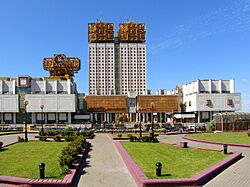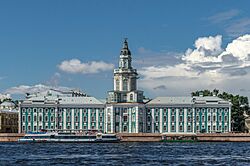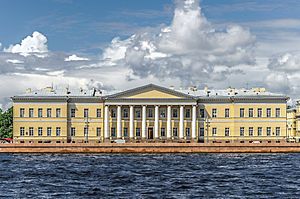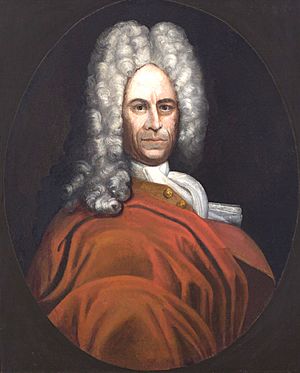Russian Academy of Sciences facts for kids
 |
|
| Established | 8 February 1724 Saint Petersburg, Russia |
|---|---|
| President | Gennady Krasnikov (since September 20, 2022) |
| Members | 1900 Russian + about 440 foreign, See also § Institutions |
| Location |
Russia
|
| Address | Leninsky prospekt 14, Moscow |
|
Building details
|
|
 |
|
The Russian Academy of Sciences (RAS) is Russia's main science organization. It includes a huge network of research centers all over Russia. It also has other important parts like libraries, publishing houses, and even hospitals.
Peter the Great started this academy in 1724. Back then, it was called the St. Petersburg Academy of Sciences. He got help and ideas from a famous thinker named Gottfried Leibniz. From the very beginning, many smart scientists from other countries came to teach and research there. In 1747, the academy got its first clear goals. For a while, it was both a university and a research center. Later, the university part stopped, and it focused only on research. Through the 18th and 19th centuries, the academy published many important scientific works and changed its name a few times. Before the Soviet era, it was known as The Imperial Saint Petersburg Academy of Sciences.
Today, the academy's main office is in Moscow. It is a non-profit group supported by the Government of Russia. In 2013, the Russian government changed how RAS worked. It gave control of the academy's buildings and research centers to a new government agency.
As of November 2017, the academy had over 1,000 different institutions and units. About 125,000 people worked there, and 47,000 of them were scientists.
Contents
Becoming a Member of the Academy
There are three main types of members in the RAS:
- Full members (called academicians)
- Corresponding members
- Foreign members
To be an academician or corresponding member, you usually need to be a citizen of Russia when you are chosen. However, some members were chosen before the Soviet Union ended and are now citizens of other countries. Scientists are picked based on their amazing contributions to science. Being elected as a member is a very big honor!
Between 2005 and 2012, the academy had about 500 full members and 700 corresponding members. In 2013, two other academies – the Russian Academy of Agricultural Sciences and the Russian Academy of Medical Sciences – joined the RAS. This made the total number of members much larger. The most recent elections for new members happened in May and June 2022.
By April 2024, the academy had 1900 Russian members (819 full members and 1081 corresponding members). It also had about 440 foreign members.
Since 2015, the academy also gives a special title called "RAS Professor" to top Russian scientists. This is not a type of membership, but these professors are often considered for future membership. Some have already become members!
How the Academy is Organized
The RAS has 13 special science divisions. It also has four main branches in different parts of Russia and 15 regional science centers. The academy also has many smaller groups like councils and committees that work on different projects.
Main Branches Across Russia
The academy has large branches that cover different regions of Russia:
- Siberian Branch of the Russian Academy of Sciences (SB RAS)
- This branch started in 1957. It has research centers in cities like Novosibirsk (known for Akademgorodok, a "science town"), Tomsk, Krasnoyarsk, and others. By the end of 2017, over 12,500 scientists worked here, including 211 academy members.
- Ural Branch of the Russian Academy of Sciences (UB RAS)
- The Ural Branch was set up in 1932. Its research centers are in cities like Yekaterinburg, Perm, and Cheliabinsk. In 2016, 112 scientists from the Ural region were members of the academy.
- St. Petersburg Branch of the Russian Academy of Sciences (SPbB RAS)
- This branch is newer, established in 2023. As of autumn 2023, 187 scientists from St. Petersburg were academy members.
- Far East Branch of the Russian Academy of Sciences (FEB RAS)
- This branch covers Russia's Far East. It includes science centers in Vladivostok, Blagoveschensk, Khabarovsk, and other cities. In 2017, 64 academy members worked in this branch.
Regional Science Centers
The RAS also has many smaller science centers in different cities, such as:
- Kazan Scientific Center
- Pushchino Scientific Center
- Samara Scientific Center
- Saratov Scientific Center
- Vladikavkaz Scientific Center
- Karelian Research Centre of RAS
- Kola Scientific Center
- Nizhny Novgorod Center
- Scientific Center of the RAS in Chernogolovka
- Ufa Scientific Center
- Southern Scientific Center
- Troitsk Scientific Center
Research Institutions
The Russian Academy of Sciences includes a large number of research institutions. These are places where scientists do their actual research. Some examples include:
- Budker Institute of Nuclear Physics
- Engelhardt Institute of Molecular Biology
- Institute for African Studies
- Institute of Far Eastern Studies
- Institute of Archaeology
- Institute for Slavic Studies of the Russian Academy of Sciences
- Institute for Spectroscopy
- Institute for System Programming
- Institute of Biomedical Problems
- Institute of Chemical Biology and Fundamental Medicine
- Institute of Economy (RAS)
- Institute of Linguistics
- Institute of Oriental Studies
- Institute of Philosophy
- Institute of Plant and Animal Ecology
- Institute of Radio-engineering and Electronics
- Institute of Solid State Physics
- Institute of State and Law
- Institute of the US and Canada (ISKRAN)
- Institute of World Economy and International Relations (IMEMO)
- Institute of World Literature
- Ioffe Physico-Technical Institute
- Keldysh Institute of Applied Mathematics
- Komarov Botanical Institute
- Landau Institute for Theoretical Physics
- Lebedev Physical Institute
- Paleontological Institute
- Pushkov Institute of Terrestrial Magnetism, Ionosphere and Radiowave Propagation (IZMIRAN)
- Space Research Institute
- Shirshov Institute of Oceanology
- Special Astrophysical Observatory
- Steklov Institute of Mathematics
- Sukachev Institute of Forest
- Vingoradov Russian Language Institute
- Institute of Scientific Information on Social Sciences
- N. D. Zelinsky Institute of Organic Chemistry
- Zoological Institute
These research places are connected by a special internet network called the Russian Space Science Internet (RSSI). It started with just three members and now has 3,100 members, including 57 of the biggest research institutions.
Russian universities are not directly controlled by the RAS. They are part of the Ministry of Education. However, many top universities, like Moscow State University and Novosibirsk State University, work closely with RAS institutes. They often use the staff and facilities of the academy for their students.
From 1933 to 1992, the main science magazine of the Soviet Academy of Sciences was called Proceedings of the USSR Academy of Sciences. After 1992, it was renamed Proceedings of the Academy of Sciences.
The academy is also getting more involved in education. In 1990, the Higher Chemical College of the Russian Academy of Sciences was started. This special university helps students choose a path in science.
Awards Given by the Academy
The academy gives out many important prizes, medals, and awards to recognize great scientific work. Some of these include:
- Lomonosov Gold Medal
- Landau Gold Medal
- Kurchatov Medal
- Demidov Prize
- Lobachevsky Prize
- Kovalevskaya Prize
- Pushkin Prize
- Lebedev Prize
- Markov Prize
- Bogolyubov Medal
History of the Academy
Beginning in the Russian Empire
How the Academy Started
The idea for the academy came from Emperor Peter the Great. He was inspired by his trips to Western Europe, where he saw many advanced universities and science centers. He also started writing letters with Gottfried Leibniz, a famous philosopher and mathematician. Leibniz was excited about Peter's wish to bring education and science to Russia. He suggested creating new schools and academies, including a special arts and sciences institution with top foreign scholars.
Following Leibniz's advice, Peter founded the St. Petersburg Academy of Science in January 1724, just before he passed away. The Senate officially started the academy on February 8, 1724. It was designed like the famous Paris Academy and the Berlin Academy of Sciences. These academies helped create a society of educated thinkers, which Peter wanted for Russia. Leibniz himself founded the Berlin Academy, showing his big influence on the St. Petersburg Academy. The Paris Academy was controlled by the King, which inspired Peter to make himself the head of the St. Petersburg Academy, even though there would also be a president.
The Academy's Early Years

Peter's wife, Empress Catherine I, made sure the academy opened in December 1725. When it first opened, it had three main departments: mathematics, physical sciences, and humanities. The academy also included a university and a high school to help promote higher education in Russia. The first 17 scholars had to teach and do research. By 1726, there were 84 staff members. Student assistants helped the scholars and taught in the high school. In its first year (1726), 112 students enrolled, with 76 being Russian and 36 foreign. The academy didn't have an official rulebook until 1747. Peter I had written down his goals for the academy in a document called the "Project," hoping it would be a model for Russia.
Since the Tsar was in charge, the presidents and directors were chosen by the royal family. This continued until the end of the Russian Empire. The academy faced tough times during Empress Anna's rule. By 1744, only 6 students remained, and teaching was in German, which Peter I had not wanted. However, in the 1740s, the academy achieved a big goal: it produced its first Russian scholar members, Stepan Krasheninnikov and Mikhail Lomonosov.
After the 1747 Rules
The academy's new rules in 1747 brought some changes. Russian and Latin became the official languages, and there was a push to translate books into Russian. The rules also hoped that Russian graduates would eventually replace all the foreign scholars. However, most high school graduates chose to work for the government instead of continuing to the university. The university part of the academy slowly faded away and was gone by 1767.
During Catherine the Great's time, she made changes to improve the academy for scientists. She created a group of academy faculty to lead the academy instead of government officials. Also, in the second half of the 18th century, more Russian scholars joined the academy's faculty. To help with disagreements between German and Russian faculty, Catherine the Great convinced Euler to come back to St. Petersburg in 1766 and lead the academy. He stayed there until he died in 1783.
Famous Scholars and Discoveries
Following Leibniz's ideas, Peter the Great asked German philosopher Christian Wolff to join the academy, but he declined. However, Wolff helped invite many Western scholars to work at the academy. These included famous mathematicians like Leonhard Euler and Daniel Bernoulli, botanist Johann Georg Gmelin, and astronomer Joseph-Nicolas Delisle.
Academy scientists led or took part in many expeditions to explore distant parts of Russia. These included Vitus Bering's Second Kamchatka Expedition (1733–1743) and expeditions to observe the transit of Venus in 1769. These trips helped create an atlas of Russia and led to new discoveries in astronomy, geography, and about plants and animals. From 1750 to 1777, the academy published 20 volumes of its science magazine, Novi Commentarii Academiae Scientiarum Imperialis Petropolitanae. Most of Russia's scientific research in the 18th century was done by academy members.
Academy Name Changes Over Time
The academy changed its name several times throughout its history:
| Official Academy Name | Years |
|---|---|
| The Saint Petersburg Academy of Sciences | 1725–1747 |
| The Imperial Academy of Sciences and Arts | 1747–1803 |
| The Imperial Academy of Sciences | 1803–1836 |
| The Imperial Saint Petersburg Academy of Sciences | 1836–1917 |
A separate group called the Russian Academy was created in 1783 to study the Russian language. It worked on creating the six-volume Academic Dictionary of the Russian Language. In 1841, this Russian Academy joined the Imperial Saint Petersburg Academy of Sciences.
During the Soviet Union Era
After the October Revolution in 1917, the academy worked with the new Soviet government. They agreed that the academy's scientific knowledge would help build the new state, and in return, the government would support the academy financially.
In the 1920s, the academy did important work like studying the large Kursk Magnetic Anomaly (a huge area with unusual magnetic forces) and minerals in the Kola Peninsula. They also helped with the GOELRO plan to bring electricity to the whole country. In 1925, the Soviet government recognized the Russian Academy of Sciences as the "highest all-Union scientific institution" and renamed it the Academy of Sciences of the Soviet Union. In 1934, the academy's main office moved from Leningrad to the capital, Moscow.
During the years of World War II, the Soviet Academy of Sciences helped a lot in developing modern weapons like new tanks and airplanes. This helped the USSR win against Nazi Germany. After the war, the academy was involved in the Soviet atomic bomb project. Because of its success in military technology, the USSR became a superpower during the Cold War.
By the late 1940s, the academy had eight main divisions for different sciences, like physics, chemistry, biology, and history. It also had committees for coordinating science work, publishing, and museums.
The Academy of Sciences of the USSR also helped set up national Academies of Sciences in all the other Soviet republics. They often sent famous scientists to live and work in these republics to help build their science programs.
Some of the most important achievements of the academy in the second half of the 20th century include the Soviet space program. In 1957, the first satellite was launched. In 1961, Yury Gagarin became the first person in space. In 1971, the first space station Salyut 1 began working. The academy also made big discoveries in nuclear science and other areas of physics. They also helped open new universities or new study programs at existing universities. The best students from these programs often started their careers at the academy's research institutes.
After the Soviet Union Ended
After the Soviet Union broke apart in 1991, the academy became the Russian Academy of Sciences again. It took over all the facilities of the USSR Academy of Sciences that were in Russia.
The economic problems of the 1990s in Russia meant there was much less government support for science. This caused many scientists to leave Russia to work in Europe, Israel, or the United States. Many talented university graduates also chose other jobs, often in business. The Russian Academy lost a generation of scientists during this time.
In the 2000s, the situation for science and technology in Russia got better. The government announced a plan to modernize science. However, by 2013, the money spent on research and development was still about 40% lower than before the economic problems of 1990. Also, there was still a "brain drain," meaning smart people were leaving the country.
Changes to the Academy Since 2013
On June 28, 2013, the Russian government announced a new law. This law would combine the RAS with two other Russian academies: the Russian Academy of Agricultural Sciences and the Russian Academy of Medical Sciences. All members from these academies would become equal members of the new, larger RAS.
The law also created a new government agency called the Federal Agency for Scientific Organizations (FASO). FASO would take control of all the academy's buildings and property. All the academy's research institutes were also taken out of the academy's direct control. Instead, FASO would decide how well research institutes were working and could change or close ones that were not efficient.
This new law caused a lot of debate and protests among scientists. Many RAS members said they would not join the new academy if the plan went through as first written. Some famous scientists from around the world called the planned changes "shocking." Because of this, the law was made a bit softer, and it was approved on September 27, 2013. In 2014, more changes were announced that gave the government even more power over science funding.
In 2017, the election of the RAS president also came under government control. In May 2018, FASO became part of Russia's new Ministry of Science and Higher Education.
Presidents of the Academy
Imperial Russia
These people served as President or Director of the academy during the time of the Russian Empire:
- Laurentius Blumentrost, 1725–1733
- Hermann Karl von Keyserling 1733–1734
- Johann Albrecht Korf, 1734–1740
- Karl von Brevern, 1740–1741
- Count Kirill Razumovsky, 1746–1766
- Count Vladimir Orlov, 1766–1774 (Director)
- Sergey Domashnev, 1775–1782 (Director)
- Princess Yekaterina Vorontsova-Dashkova, 1783–1796 (Director)
- Ludwig Heinrich von Nicolay, 1798–1803
- Nikolay Novosiltsev, 1803–1810
- Count Sergey Uvarov, 1818–1855
- Dmitry Bludov, 1855–1864
- Fyodor Litke, 1864–1882
- Count Dmitry Tolstoy, 1882–1889
- Grand Duke Constantine Constantinovich of Russia, 1889–1915
Soviet Russia
These people led the academy during the Soviet Union:
- Alexander Karpinsky, 1917–1936
- Vladimir Komarov, 1936–1945
- Sergey Vavilov, 1945–1951
- Alexander Nesmeyanov, 1951–1961
- Mstislav Keldysh, 1961–1975
- Anatoly Alexandrov, 1975–1986
- Gury Marchuk, 1986–1991
Russian Federation
These people have led the academy since the Russian Federation was formed:
- Yury Osipov, 1991–2013
- Vladimir Fortov, 2013–2017
- Valery Kozlov, 2017 (acting)
- Alexander Sergeev, 2017–2022
- Gennady Krasnikov, since Sept 2022
Major Achievements and Nobel Prize Winners
Academy Members in Public Life

Scientists from the academy have often been chosen to be part of the government. For example, in 1974, 22 scientists from the Academy of Sciences were deputies in the Supreme Soviet of the USSR. In 1989, Andrei Sakharov, a famous academician and human rights activist, became a People's Deputy of the USSR. Many scientists have also worked in the State Duma of the Russian Federation, which is like Russia's parliament.
Nobel Prize Winners from the Academy
Many scientists connected to the Russian Academy of Sciences have won the Nobel Prize, one of the highest honors in the world. Here are some of them:
- Ivan Petrovich Pavlov, medicine, 1904 (for his work on digestion, including "Pavlov's dogs")
- Ilya Ilyich Mechnikov, medicine, 1908 (for his work on immunity)
- Nikolay Nikolayevich Semyonov, chemistry, 1956
- Igor Yevgenyevich Tamm, physics, 1958
- Ilya Mikhailovich Frank, physics, 1958
- Pavel Alekseyevich Cherenkov, physics, 1958
- Lev Davidovich Landau, physics, 1962
- Nikolay Gennadiyevich Basov, physics, 1964
- Aleksandr Mikhailovich Prokhorov, physics, 1964
- Leonid Vitaliyevich Kantorovich, economics, 1975
- Andrei Dmitrievich Sakharov, peace, 1975 (for his work on human rights)
- Pyotr Leonidovich Kapitsa, physics, 1978
- Zhores Ivanovich Alferov, physics, 2000
- Alexei Alexeyevich Abrikosov, physics, 2003
- Vitaly Lazarevich Ginzburg, physics, 2003
- Andre Geim, physics, 2010
See also
 In Spanish: Academia de Ciencias de Rusia para niños
In Spanish: Academia de Ciencias de Rusia para niños
- Academy of Sciences Glacier
- Academy of Sciences Range
- Akademgorodok in Novosibirsk (a famous "science town")
- Library of the Russian Academy of Sciences
- List of Russian scientists
- MARS-500 (a project to simulate a mission to Mars)
- Nauka, RAS publishing division
- Pushchino Radio Astronomy Observatory
- Timeline of Russian inventions and technology records
- Named prizes and medals of the Russian Academy of Sciences
Images for kids






